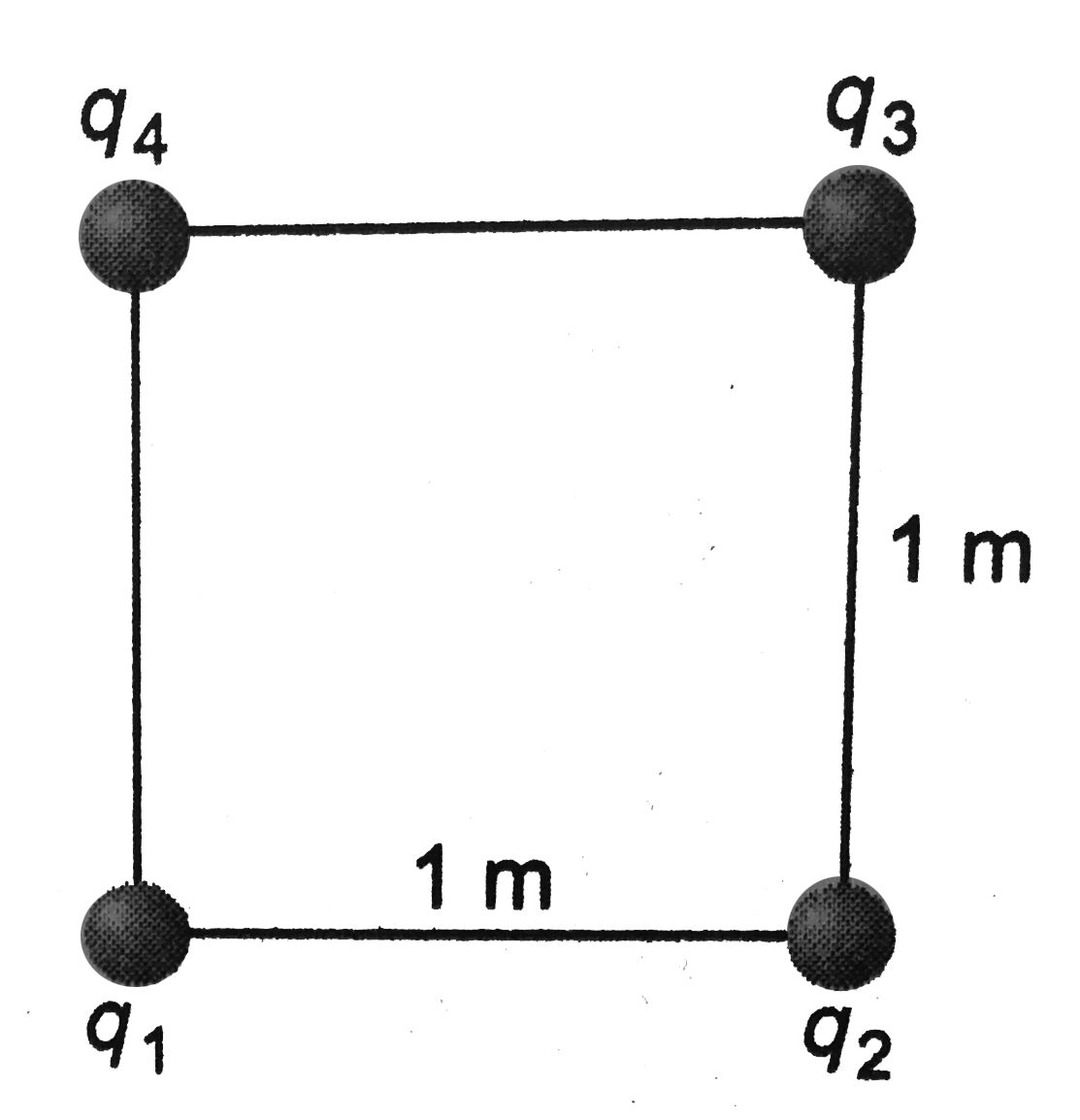Two points charges are located on the x-axis, q1=−1μC at x=0andq2=+1μc at x=1m.
a. Find the work that must be done by an external force to bring a third point charge q3=+1μC from infinity to x=2m.
b. Find the total potential energy of the system of three charges.
To solve the problem, we will break it down into two parts as specified in the question.
Part A: Work Done to Bring Charge q3
1. Identify the Charges and Their Positions:
- q1=−1μC at x=0
- q2=+1μC at x=1m
- q3=+1μC is to be brought from infinity to x=2m
2. Calculate the Work Done:
The work done W in bringing a charge from infinity to a point in an electric field is equal to the change in potential energy U of the system. The potential energy U between two point charges is given by:
U=14πϵ0q1q2r
where r is the distance between the charges.
3. Calculate the Potential Energy Contributions:
- From q1 and q3:
U13=14πϵ0q1q3r13=14πϵ0(−1×10−6)(1×10−6)2=−18πϵ0×10−12
- From q2 and q3:
U23=14πϵ0q2q3r23=14πϵ0(1×10−6)(1×10−6)1=14πϵ0×10−12
- From q1 and q2:
U12=14πϵ0q1q2r12=14πϵ0(−1×10−6)(1×10−6)1=−14πϵ0×10−12
4. Total Potential Energy:
The total potential energy U of the system when q3 is brought to x=2m is:
U=U13+U23+U12
Substituting the values:
U=−18πϵ0×10−12+14πϵ0×10−12−14πϵ0×10−12
Simplifying, we find:
U=−18πϵ0×10−12
5. Calculate Work Done:
Since the work done W is equal to the change in potential energy, we can express it as:
W=Ufinal−Uinitial=U23+U13+U12
After calculating, we find:
W=4.5×10−3J
Part B: Total Potential Energy of the System
1. Total Potential Energy of the System:
The total potential energy U of the system of three charges is given by the sum of the potential energies calculated previously:
U=U13+U23+U12
2. Substituting the Values:
Using the values calculated in Part A:
U=−18πϵ0×10−12+14πϵ0×10−12−14πϵ0×10−12
After simplification, we find:
U=−4.5×10−3J
Final Answers:
- Part A: The work done W=4.5×10−3J
- Part B: The total potential energy of the system U=−4.5×10−3J
- q1=−1μC at x=0
- q2=+1μC at x=1m
- q3=+1μC is to be brought from infinity to x=2m
The work done W in bringing a charge from infinity to a point in an electric field is equal to the change in potential energy U of the system. The potential energy U between two point charges is given by:
U=14πϵ0q1q2r
where r is the distance between the charges.
- From q1 and q3:
U13=14πϵ0q1q3r13=14πϵ0(−1×10−6)(1×10−6)2=−18πϵ0×10−12
- From q2 and q3:
U23=14πϵ0q2q3r23=14πϵ0(1×10−6)(1×10−6)1=14πϵ0×10−12
- From q1 and q2:
U12=14πϵ0q1q2r12=14πϵ0(−1×10−6)(1×10−6)1=−14πϵ0×10−12
The total potential energy U of the system when q3 is brought to x=2m is:
U=U13+U23+U12
Substituting the values:
U=−18πϵ0×10−12+14πϵ0×10−12−14πϵ0×10−12
Simplifying, we find:
U=−18πϵ0×10−12
Since the work done W is equal to the change in potential energy, we can express it as:
W=Ufinal−Uinitial=U23+U13+U12
After calculating, we find:
W=4.5×10−3J
The total potential energy U of the system of three charges is given by the sum of the potential energies calculated previously:
U=U13+U23+U12
Using the values calculated in Part A:
U=−18πϵ0×10−12+14πϵ0×10−12−14πϵ0×10−12
After simplification, we find:
U=−4.5×10−3J
- Part A: The work done W=4.5×10−3J
- Part B: The total potential energy of the system U=−4.5×10−3J
Topper's Solved these Questions
- ELECTROSTATIC POTENTIAL AND CAPACITORSBOOK - DC PANDEY ENGLISHCHAPTER - ELECTROSTATIC POTENTIAL AND CAPACITORSEXERCISE - Check point 2.1
15 Videos
- ELECTROSTATIC POTENTIAL AND CAPACITORSBOOK - DC PANDEY ENGLISHCHAPTER - ELECTROSTATIC POTENTIAL AND CAPACITORSEXERCISE - Check point 2.2
15 Videos
- ELECTROMAGNETIC WAVESBOOK - DC PANDEY ENGLISHCHAPTER - ELECTROMAGNETIC WAVESEXERCISE - Sec C
22 Videos
- ELECTROSTATICSBOOK - DC PANDEY ENGLISHCHAPTER - ELECTROSTATICSEXERCISE - Medical entrances gallery
37 Videos
Similar Questions
Two point charges are located on the x - axis : q1=−e at x=0 and q2=+e at x=a.
The work done by an external force to bring a third point charge q3=+e from infinity to x=2a is.
View SolutionFind the work done by some external force in moving a charge q=2μC from infinity to a point where electric potential is 104 V.
View SolutionFind the work done by some external force in moving a charge q=4μC from infinity to a point, where electric potential is 104V
View SolutionTwo point charges are located on the x - axis : q1=−e at x=0 and q2=+e at x=a. A third charge q3=+e is brought to x=2a.
The total potential energy of the system of three charges.
View SolutionWhat minimum work must be done by an external force to bring a charge q=3.00μC from a great distance away (take t=∞) to a point 0.500m from a charge =20.0μC ?
View SolutionA charge Q is placed at the origin. The electric potential due to this charge at a given point in space is V. The work done by an external force in bringing another charge q from infinity up to the point is
View SolutionA charge q1=2.00μC is located at the origin , and a charge q2=−6.00μC is located at (0,3.00)m.
(a) Find the total electric potential due to these charges at the point P hose coordinates are ( 4.00,0) m .
( b) Find the change in potential energy of the system of two charges plus a charge q3=3.00μC as the latter charge moves from infinity to point P .
View SolutionA point charge q1=4.00nC is placed at the origin, and a second point charge q2=−3.00nC, placed on the x-axis at x = + 20.0 cm. A third point charge q3=2.00nC is placed on the X-axis between q1,andq2. (Take as zero the potential energy of the three charges when they are infinitely far apart).
(a) What is the potential energy of the system of the three charges if q3 is placed at x= + 10.0 cm?
(b) Where should q3 be placed to make the potential energy of the system equal to zero?
View SolutionFor charges q1=1μC,q2=2μC,q3=−3μC and q4=4μC are kept on the vertices of a square of side 1m. Find the electric potential energy of this system of charges.

View SolutionFour charges q1=1μC,q2=2μC,q3=−3μCandq4=4μC are kept on the vertices of a square of side 1m. Find the electric potential energy of this system of charges.
View Solution
